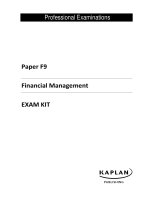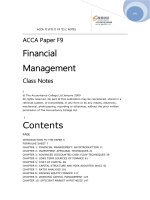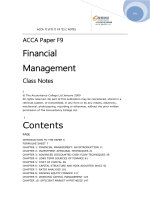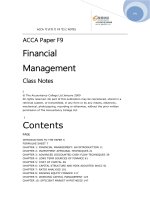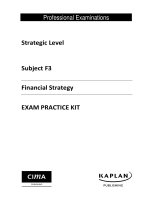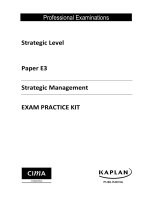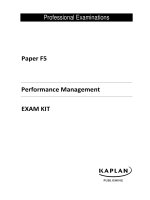ACCA paper f9 financial management EXAM KIT
Bạn đang xem bản rút gọn của tài liệu. Xem và tải ngay bản đầy đủ của tài liệu tại đây (2.34 MB, 408 trang )
Professional Examinations
Paper F9
Financial Management
EXAM KIT
P AP E R F9 : FINAN CIAL MANA GEME NT
British Library Cataloguing‐in‐Publication Data
A catalogue record for this book is available from the British Library.
Published by:
Kaplan Publishing UK
Unit 2 The Business Centre
Molly Millar’s Lane
Wokingham
Berkshire
RG41 2QZ
ISBN: 978‐1‐78415‐231‐4
© Kaplan Financial Limited, 2015
Printed and bound in Great Britain.
The text in this material and any others made available by any Kaplan Group company does not
amount to advice on a particular matter and should not be taken as such. No reliance should be
placed on the content as the basis for any investment or other decision or in connection with any
advice given to third parties. Please consult your appropriate professional adviser as necessary.
Kaplan Publishing Limited and all other Kaplan group companies expressly disclaim all liability to
any person in respect of any losses or other claims, whether direct, indirect, incidental,
consequential or otherwise arising in relation to the use of such materials.
All rights reserved. No part of this examination may be reproduced or transmitted in any form or
by any means, electronic or mechanical, including photocopying, recording, or by any information
storage and retrieval system, without prior permission from Kaplan Publishing.
Acknowledgements
The past ACCA examination questions are the copyright of the Association of Chartered Certified
Accountants. The original answers to the questions from June 1994 onwards were produced by
the examiners themselves and have been adapted by Kaplan Publishing.
We are grateful to the Chartered Institute of Management Accountants and the Institute of
Chartered Accountants in England and Wales for permission to reproduce past examination
questions. The answers have been prepared by Kaplan Publishing.
i i
KA PLAN PUBLISHING
CONTENTS
Page
Index to questions and answers
v
Analysis of past exam papers
xi
Exam Technique
xiii
Paper specific information
xv
Kaplan’s recommended revision approach
xix
Kaplan’s detailed revision plan
xxiii
Mathematical tables and formulae sheet
xxvii
Section
1
Objective Test Questions – Section A
1
2
Practice Questions – Section B
39
3
Practice Examination Paper 1 – Section C
103
4
Practice Examination Paper 2 – Section D
113
5
Answers to Objective Test Questions – Section A
121
6
Answers to Practice Questions – Section B
141
7
Answers to Practice Examination Paper 1 – Section C
333
8
Answers to Practice Examination Paper 2 – Section D
343
Specimen Exam
KA PLAN PUBLISHING
i i i
P AP E R F9 : FINAN CIAL MANA GEME NT
Key features in this edition
In addition to providing a wide ranging bank of real past exam questions, we have also included
in this edition:
An analysis of all of the recent examination papers.
Paper specific information and advice on exam technique.
Our recommended approach to make your revision for this particular subject as effective
as possible.
This includes step by step guidance on how best to use our Kaplan material (Complete
text, pocket notes and exam kit) at this stage in your studies.
Enhanced tutorial answers packed with specific key answer tips, technical tutorial notes
and exam technique tips from our experienced tutors.
Complementary online resources including full tutor debriefs and question assistance to
point you in the right direction when you get stuck.
You will find a wealth of other resources to help you with your studies on the following sites:
www.MyKaplan.co.uk
www.accaglobal.com/students/
Quality and accuracy are of the utmost importance to us so if you spot an error in any of our
products, please send an email to with full details, or follow the
link to the feedback form in MyKaplan.
Our Quality Co‐ordinator will work with our technical team to verify the error and take action to
ensure it is corrected in future editions.
i v
KA PLAN PUBLISHING
INDEX TO QUESTIONS AND ANSWERS
INTRODUCTION
Past exam questions have been modified (sometimes extensively) to reflect the current F9
syllabus and exam structure.
KEY TO THE INDEX
PAPER ENHANCEMENTS
We have added the following enhancements to the answers in this exam kit:
Key answer tips
All answers include key answer tips to help your understanding of each question.
Tutorial note
Many answers include more tutorial notes to explain some of the technical points in more detail.
Top tutor tips
For selected questions, we “walk through the answer” giving guidance on how to approach the
questions with helpful ‘tips from a top tutor’, together with technical tutor notes.
These answers are indicated with the “footsteps” icon in the index.
KA PLAN PUBLISHING
v
P AP E R F9 : FINAN CIAL MANA GEME NT
ONLINE ENHANCEMENTS
Timed question with Online tutor debrief
For selected questions, we recommend that they are to be completed in full exam conditions (i.e.
properly timed in a closed book environment).
In addition to the examiner’s technical answer, enhanced with key answer tips and tutorial notes
in this exam kit, online you can find an answer debrief by a top tutor that:
works through the question in full
points out how to approach the question
shows how to ensure that the easy marks are obtained as quickly as possible, and
emphasises how to tackle exam questions and exam technique.
These questions are indicated with the “clock” icon in the index.
Online question assistance
Have you ever looked at a question and not known where to start, or got stuck part way through?
For selected questions, we have produced “Online question assistance” offering different levels of
guidance, such as:
ensuring that you understand the question requirements fully, highlighting key terms and
the meaning of the verbs used
how to read the question proactively, with knowledge of the requirements, to identify the
topic areas covered
assessing the detailed content of the question body, pointing out key information and
explaining why it is important
help in devising a plan of attack
With this assistance, you should then be able to attempt your answer confident that you know
what is expected of you.
These questions are indicated with the “signpost” icon in the index.
Online question enhancements and answer debriefs will be available on MyKaplan at:
www.MyKaplan.co.uk
v i
KA PLAN PUBLISHING
INDEX TO QU ES TIO NS AND ANSWE RS
FINANCIAL MANAGEMENT FUNCTION AND ENVIRONMENT
Page number
1
UUL Co
2
3
4
5
CCC
Neighbouring countries
RZP Co
Dazzle Co
6
JJG Co
7
News for you
WORKING CAPITAL MANAGEMENT
8
9
10
11
Gorwa Co
Flit Co
Wobnig Co
FLG Co
12
PKA Co
13
14
15
KXP Co
Ulnad
APX Co
16
HGR Co
17
18
Anjo Co
ZSE Co
19
PNP Co
20
Plot Co
21
WQZ Co
INVESTMENT APPRAISAL
22
Armcliff Co
23
24
25
26
27
28
29
Uftin Co
Warden Co
Dairy Co
Investment appraisal
Darn Co
Charm Co
Play Co
30
Duo Co
KA PLAN PUBLISHING
Question
141
−
39
40
40
41
142
144
145
146
−
−
−
Dec 08
41
148
June 09
42
150
−
43
44
45
45
152
155
157
160
Dec 08
Dec 14
June 12
June 08
46
163
Dec 07
46
47
48
167
170
173
Dec 12
−
Dec 09
49
177
June 09
50
52
181
183
−
June 10
52
187
June 07
53
189
Dec 13
54
190
Dec 10
55
194
−
56
58
58
59
59
60
61
196
199
202
204
208
211
213
Dec 14
Dec 11
−
−
Dec 13
−
−
62
215
Dec 07
Past exam
39
Answer
v i i
P AP E R F9 : FINAN CIAL MANA GEME NT
Page number
31
32
33
34
OKM Co
BRT Co
Umunat Co
Victory
35
Springbank Co
36
37
38
39
40
CJ Co
Basril
ASOP Co
Cavic
Hypermarket
Question
BUSINESS FINANCE AND COST OF CAPITAL
Answer
Past exam
63
64
65
65
220
222
226
228
June 10
June 11
−
−
66
230
−
67
67
68
69
69
232
235
237
240
242
Dec 10
−
Dec 09
−
41
42
43
44
FMY
Tinep Co
Fence Co
RWF
70
70
71
72
244
247
249
252
−
Dec 14
June 14
−
45
46
Bar Co
Nugfer
73
74
254
257
Dec 11
Dec 10
47
Spot Co
75
261
Dec 13
48
Echo Co
75
263
Dec 07
49
50
51
52
Zigto Co
Pavlon
Arwin
Associated International Supplies Co
76
77
78
79
267
269
271
273
June 12
−
−
−
53
AMH Co
80
276
June 13
54
GTK Co
81
279
June 07
55
TFR
81
282
June 07
56
GXG Co
82
285
June 13
57
58
59
60
61
62
Droxfol
Ill colleague
AQR Co
GM Co
Card Co
IRQ Co
83
84
85
86
86
87
288
290
291
295
296
298
−
−
June 11
−
Dec 13
−
v i ii
KA PLAN PUBLISHING
INDEX TO QU ES TIO NS AND ANSWE RS
BUSINESS VALUATIONS
Page number
63
Close Co
64
65
66
67
68
Par Co
MFZ Co
NN Co
Corhig Co
MAT Co
69
Question
Answer
Past exam
88
300
Dec 11
89
90
90
92
92
302
303
305
306
309
Dec 14
June 14
Dec 10
June 12
−
THP Co
93
311
June 08
70
Dartig Co
95
314
Dec 08
71
Phobis
95
316
Dec 07
96
97
97
319
320
321
−
Dec 14
−
RISK MANAGEMENT
72
73
74
Nedwen
PZK Co
Lagrag Co
75
Boluje Co
98
322
Dec 08
76
Exporters plc
99
324
−
77
Elect Co
99
325
−
78
Limes Co
100
328
June 13
79
CC Co
101
330
−
KA PLAN PUBLISHING
i x
P AP E R F9 : FINAN CIAL MANA GEME NT
x
KA PLAN PUBLISHING
ANALYSIS OF PAST PAPERS
The table below summarises the key topics that have been tested within the written test
questions in the examinations to date.
D10
J11
D11
J12
Nature and purpose of financial
management
Financial objectives and
corporate strategy
Stakeholders and their impact on
corporate strategy
Not for profits
Financial management
environment
Economic environment
Financial markets and
institutions
Working capital management
Elements and importance
(including cash operating cycle)
Inventories
Receivables
Payables
Cash
Working capital needs and
funding strategies
Investment appraisal
Non‐discounted techniques
NPV with tax
IRR
Risk and uncertainty
Lease or buy
Asset replacement
Capital rationing
Financial management function
Appraisal process
NPV with tax and inflation
KA PLAN PUBLISHING
D12
J13
D13
J14
D14
x i
P AP E R F9 : FINAN CIAL MANA GEME NT
D10
J11
D11
J12
D12
J13
D13
J14
D14
Business finance and cost of
capital
Sources of short term finance
Sources of long term finance
Internal sources and dividend
policy
Gearing and capital structure
Small & medium enterprises
Islamic financing
Sources and relative costs
CAPM
Estimating cost of equity
Cost of debt
Overall cost of capital
Gearing theories
Impact of cost of capital on
investments
Business valuations
Nature and purpose of valuation
Risk management
Foreign exchange risk
Forward contracts
Money market hedge
Futures
Hedging for interest rate risk
Models for valuing shares
Valuing debt and other financial
assets
Efficient markets hypothesis
Interest rate risk
x ii
KA PLAN PUBLISHING
EXAM TECHNIQUE
Use the allocated 15 minutes reading and planning time at the beginning of the exam:
–
read the questions and examination requirements carefully, and
–
begin planning your answers.
See the Paper Specific Information for advice on how to use this time for this paper.
Divide the time you spend on questions in proportion to the marks on offer:
–
there are 1.8 minutes available per mark in the examination.
–
within that, try to allow time at the end of each question to review your answer and
address any obvious issues.
Whatever happens, always keep your eye on the clock and do not over run on any part of
any question!
Spend the last five minutes of the examination:
–
reading through your answers, and
–
making any additions or corrections.
If you get completely stuck with a question:
–
leave space in your answer book, and
–
return to it later.
Stick to the question and tailor your answer to what you are asked.
–
pay particular attention to the verbs in the question.
If you do not understand what a question is asking, state your assumptions.
Even if you do not answer in precisely the way the examiner hoped, you should be given some
credit, if your assumptions are reasonable.
You should do everything you can to make things easy for the marker.
The marker will find it easier to identify the points you have made if your answers are legible.
Written elements of questions:
Your answer should have a clear structure
Be concise.
It is better to write a little about a lot of different points than a great deal about one or two
points.
Computations:
It is essential to include all your workings in your answers.
Many computational questions require the use of a standard format:
e.g. net present values, writing down allowances and cash budgets.
Be sure you know these formats thoroughly before the exam and use the layouts that you see
in the answers given in this book and in model answers.
Reports, memos and other documents:
Some questions ask you to present your answer in the form of a report, a memo, a letter or
other document.
Make sure that you use the correct format – there could be easy marks to gain here.
KA PLAN PUBLISHING
x ii i
P AP E R F9 : FINAN CIAL MANA GEME NT
x iv
KA PLAN PUBLISHING
PAPER SPECIFIC INFORMATION
THE EXAM
FORMAT OF THE EXAM
All questions are compulsory. The exam will contain both computational and discursive
elements. Some questions will adopt a scenario/case study approach.
Section A of the exam comprises 20 multiple choice questions of 2 marks each.
Section B of the exam comprises three 10 mark questions and two 15 mark questions.
The two 15 mark questions will come from working capital management, investment appraisal
and business finance areas of the syllabus. The section A questions and the other questions in
section B can cover any area of the syllabus.
Total time allowed: 3 hours plus 15 minutes reading and planning time.
PASS MARK
The pass mark for all ACCA Qualification examination papers is 50%.
READING AND PLANNING TIME
Remember that all three hour paper based examinations have an additional 15 minutes reading
and planning time.
ACCA GUIDANCE
ACCA guidance on the use of this time is as follows:
This additional time is allowed at the beginning of the examination to allow candidates to read
the questions and to begin planning their answers before they start to write in their answer
books.
This time should be used to ensure that all the information and, in particular, the exam
requirements are properly read and understood.
During this time, candidates may only annotate their question paper. They may not write anything
in their answer booklets until told to do so by the invigilator.
KA PLAN PUBLISHING
x v
P AP E R F9 : FINAN CIAL MANA GEME NT
KAPLAN GUIDANCE
As all questions are compulsory, there are no decisions to be made about choice of questions,
other than in which order you would like to tackle them.
Therefore, in relation to F9, we recommend that you take the following approach with your
reading and planning time:
Skim through the whole paper, assessing the level of difficulty of each question.
Write down on the question paper next to the mark allocation the amount of time you
should spend on each part. Do this for each part of every question.
Decide the order in which you think you will attempt each question:
This is a personal choice and you have time on the revision phase to try out different
approaches, for example, if you sit mock exams.
A common approach is to tackle the question you think is the easiest and you are most
comfortable with first. Others may prefer to tackle the longest questions first, or
conversely leave them to the last.
Psychologists believe that you usually perform at your best on the second and third
question you attempt, once you have settled into the exam, so not tackling the hardest
question first may be advisable.
It is usual however that student tackle their least favourite topic and/or the most difficult
question in their opinion last.
Whatever you approach, you must make sure that you leave enough time to attempt all
questions fully and be very strict with yourself in timing each question.
For each question in turn, read the requirements and then the detail of the question
carefully.
Always read the requirement first as this enables you to focus on the detail of the
question with the specific task in mind.
For computational questions:
Highlight key numbers/information and key words in the question, scribble notes to
yourself on the question paper to remember key points in your answer.
Jot down proformas required if applicable.
For written questions:
Plan the key areas to be addressed and your use of titles and sub‐titles to enhance your
answer.
For all questions:
Spot the easy marks to be gained in a question and parts which can be performed
independently of the rest of the question. For example, laying out basic proformas
correctly, entering discount factors or calculating writing down allowances or attempting
the more discussional part of the question. Make sure that you do these parts first when
you tackle the question.
Don’t go overboard in terms of planning time on any one question – you need a good
measure of the whole paper and a plan for all of the questions at the end of the
15 minutes.
x vi
KA PLAN PUBLISHING
P A PER S PE CI F IC IN FORMA TION
By covering all questions you can often help yourself as you may find that facts in one
question may remind you of things you should put into your answer relating to a different
question.
With your plan of attack in mind, start answering your chosen question with your plan to
hand, as soon as you are allowed to start.
Always keep your eye on the clock and do not over run on any part of any question!
DETAILED SYLLABUS
The detailed syllabus and study guide written by the ACCA can be found at:
www.accaglobal.com/students/
KA PLAN PUBLISHING
x vi i
P AP E R F9 : FINAN CIAL MANA GEME NT
x vi i i
KA PLAN PUBLISHING
KAPLAN’S RECOMMENDED REVISION
APPROACH
QUESTION PRACTICE IS THE KEY TO SUCCESS
Success in professional examinations relies upon you acquiring a firm grasp of the required
knowledge at the tuition phase. In order to be able to do the questions, knowledge is essential.
However, the difference between success and failure often hinges on your exam technique on the
day and making the most of the revision phase of your studies.
The Kaplan complete text is the starting point, designed to provide the underpinning knowledge
to tackle all questions. However, in the revision phase, pouring over text books is not the answer.
MyKaplan knowledge check tests help you consolidate your knowledge and understanding and
are a useful tool to check whether you can remember key topic areas.
Kaplan pocket notes are designed to help you quickly revise a topic area, however you then need
to practise questions. There is a need to progress to full exam standard questions as soon as
possible, and to tie your exam technique and technical knowledge together.
The importance of question practice cannot be over‐emphasised.
The recommended approach below is designed by expert tutors in the field, in conjunction with
their knowledge of the examiner and their recent real exams.
The approach taken for the fundamental papers is to revise by topic area. However, with the
professional stage papers, a multi topic approach is required to answer the scenario based
questions.
You need to practice as many questions as possible in the time you have left.
OUR AIM
Our aim is to get you to the stage where you can attempt exam standard questions confidently, to
time, in a closed book environment, with no supplementary help (i.e. to simulate the real
examination experience).
Practising your exam technique on real past examination questions, in timed conditions, is also
vitally important for you to assess your progress and identify areas of weakness that may need
more attention in the final run up to the examination.
In order to achieve this we recognise that initially you may feel the need to practise some
questions with open book help and exceed the required time.
The approach below shows you which questions you should use to build up to coping with exam
standard question practice, and references to the sources of information available should you
need to revisit a topic area in more detail.
KA PLAN PUBLISHING
x ix
P AP E R F9 : FINAN CIAL MANA GEME NT
Remember that in the real examination, all you have to do is:
attempt all questions required by the exam
only spend the allotted time on each question, and
get them at least 50% right!
Try and practice this approach on every question you attempt from now to the real exam.
EXAMINER COMMENTS
We have included the examiner’s comments to the specific new syllabus examination questions in
this kit for you to see the main pitfalls that students fall into with regard to technical content.
However, too many times in the general section of the report, the examiner comments that
students had failed due to:
“misallocation of time”
“running out of time” and
showing signs of “spending too much time on an earlier questions and clearly rushing the
answer to a subsequent question”.
Good exam technique is vital.
xx
KA PLAN PUBLISHING
THE KAPLAN PAPER F9 REVISION PLAN
Stage 1: Assess areas of strengths and weaknesses
Review the topic listings in the revision table plan below
Determine whether or not the area is one with which you are comfortable
Comfortable
with the technical content
Not comfortable
with the technical content
Read the relevant chapter(s) in
Kaplan’s Complete Text
Attempt the Test your understanding
examples if unsure of an area
Attempt appropriate Online Fixed
Tests
Review the pocket notes on this area
Stage 2: Practice questions
Follow the order of revision of topics as recommended in the revision table plan below and
attempt the questions in the order suggested.
Try to avoid referring to text books and notes and the model answer until you have completed
your attempt.
Try to answer the question in the allotted time.
Review your attempt with the model answer and assess how much of the answer you achieved in
the allocated exam time.
KA PLAN PUBLISHING
xx i
P AP E R F9 : FINAN CIAL MANA GEME NT
Fill in the self‐assessment box below and decide on your best course of action.
Not comfortable with question attempts
Comfortable with question attempt
Focus on these areas by:
Reworking test your understanding
examples in Kaplan’s Complete Text
Revisiting the technical content from
Kaplan’s pocket notes
Working any remaining questions on
that area in the exam kit
Reattempting an exam standard
Only revisit when comfortable with
question in that area, on a timed,
questions on all topic areas
closed book basis
Note that:
The “footsteps questions” give guidance on exam techniques and how you should have
approached the question.
The “clock questions” have an online debrief where a tutor talks you through the exam
technique and approach to that question and works the question in full.
Stage 3: Final pre‐exam revision
We recommend that you attempt at least one three hour mock examination containing a set of
previously unseen exam standard questions.
It is important that you get a feel for the breadth of coverage of a real exam without advanced
knowledge of the topic areas covered – just as you will expect to see on the real exam day.
Ideally this mock should be sat in timed, closed book, real exam conditions and could be:
a mock examination offered by your tuition provider, and/or
the pilot paper in the back of this exam kit, and/or
the last real examination paper (available shortly afterwards on MyKaplan with “enhanced
walk through answers” and a full “tutor debrief”).
xx ii
KA PLAN PUBLISHING
THE DETAILED REVISION PLAN
Topic
Investment appraisal
Complete
Text
Chapter
2 & 3
note
Chapter
2 & 3
–
Further aspects
of discounted
cash flows
4
4
–
Risk and
uncertainty
6
6
–
Asset investment
decisions and
capital rationing
5
5
Tutor guidance
Questions
to
attempt
26
Start with the basics – remind yourself of
27
the four techniques and ensure you can
compare and contrast between them.
Start with question 26 before attempting
question 27 as an example of a recent
past exam question in this area.
A popular exam topic, guaranteed to
25
form part of the exam. There are many
31
questions on this area.
Start with questions 25 and 31 which are
basic warm up questions.
Build up to questions 28 and 29 which
are slightly more complex questions on
this area.
33
This is an aspect that is often examined
30
alongside the more complex areas of
discounted cash flow techniques.
Question 34 is another good example of
how this topic can be examined.
37
This is an area that has not been widely
38
examined within the recent exam diets.
Despite this, it is worth having a quick
recap of the techniques using these two
questions.
Date
attempted
Self assessment
KA PLAN PUBLISHING
xx iii
P AP E R F9 : FINAN CIAL MANA GEME NT
Topic
Working capital
management
Complete
Text
Chapter
7
note
Chapter
7
–
Receivables and
payables
9
9
–
Inventory
8
8
–
Cash and funding
strategies
10
10
Financial management
function
1
1
Questions
Tutor guidance
to
attempt
–
Begin by recapping on the key ratio
calculations relating to working capital
management and the calculation of the
cash operating cycle.
17
Questions
on
working
capital
management will often draw upon
several different elements. Question 16
gives a good general introduction to the
cash operating cycle.
20
This question covers many aspects of
working capital management and is a
good illustration of the way the examiner
tends to tackle this topic.
16
Question 16 contains good coverage of
18
this chapter. Question 15 covers an area
that has not been widely examined.
5
Now is a good point to visit some of the
less widely examined areas of the
syllabus. Question 4 is a good example
of how these more discursive elements
are examined.
Date
attempted
Self assessment
xx iv
KA PLAN PUBLISHING
KA PLAN’ S DE TA ILE D REV IS ION PLAN
Topic
Complete
Text
Chapter
11
note
Chapter
11
12
12
–
Sources of finance
15
15
54
Financial ratios
19
19
55
The cost of capital
17
17
62
60
The economic
environment for
business
Financial markets and
the treasury function
Questions
Tutor guidance
Date
to
attempted
attempt
7
Question 7 reflects how this topic could
be examined.
This is a fairly new area to the syllabus
but it’s worth covering this before you
start reviewing the topics of business
finance and risk management.
Question 54, taken from the June 07
exam, is an excellent illustration of the
way the examiner will often pull from
more than one syllabus area within his
questions.
Questions involving the calculation and
interpretation of financial ratios are very
common. You must be able to calculate
each of the key ratios as well as
appreciate how they interrelate with
each other.
This is another popular exam topic. As
well as reviewing the complete text and
the pocket notes, ensure you download
and review the examiner’s series of
articles relating to CAPM.
Self assessment
KA PLAN PUBLISHING
xx v



